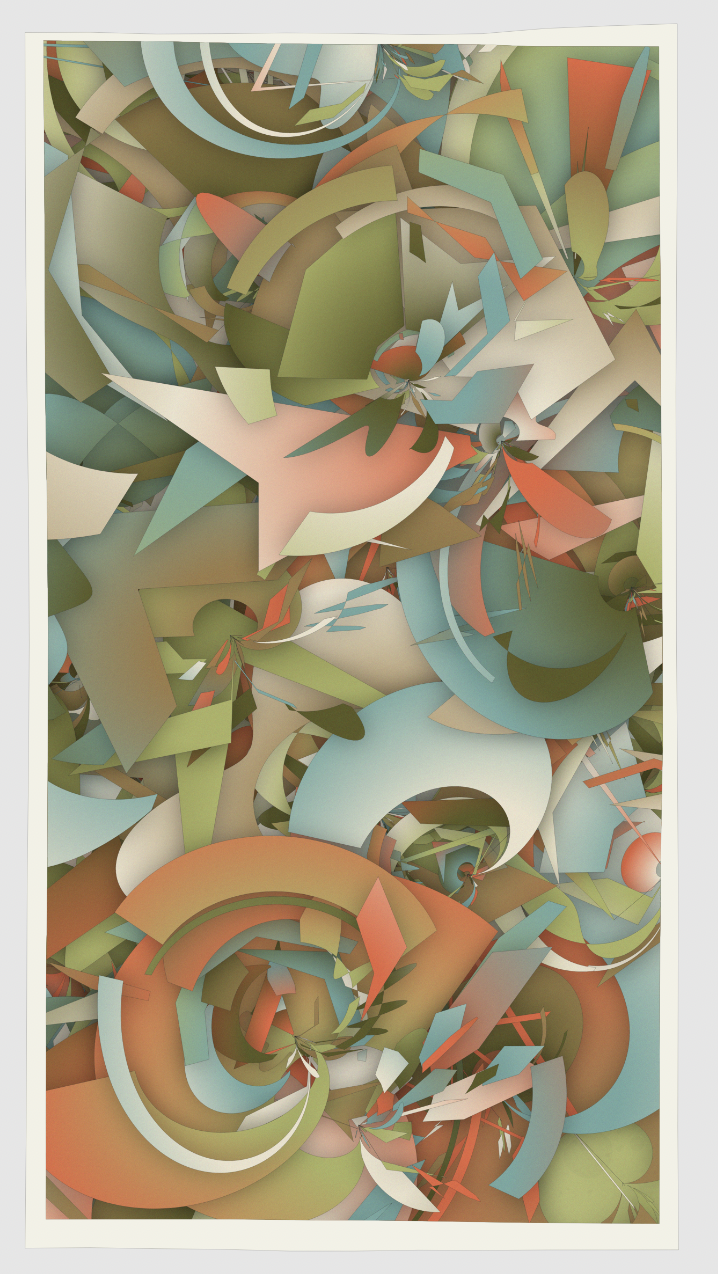MARCHING RESONANCES BY TAKAWO
This was part of an ongoing series of articles that released was digitally in May 2023. They were first published in the print edition of the Bright Moments Quarterly that was distributed at Bright Moments Tokyo in Tokyo, Japan.
Malte Rauch: Thanks so much for taking the time to do this interview, Shunsuke Takawo. You recently participated in the RCS Tokyo event and we are currently preparing Bright Moments Tokyo. Do you have the feeling the gen art world is waking up to what is going on in Japan?
高尾さん、このインタビューに時間を割いていただきありがとうございます。先日は、RCSの東京のイベントに参加されていて、現在では私たちがBright Moments Tokyoの準備を進めています。日本で起こっていることに対して、ジェネラティブアートの世界が目覚めつつあるのを感じたりしますか?
Shunsuke Takawo: First and foremost, I'd like to express my gratitude for this incredible interview opportunity! Indeed, the Japanese art scene has recently garnered global attention, yet I believe this is due to "external pressures" like Right Click Live. At the same time, the domestic atmosphere remains rather indifferent. Drawing a parallel to Japan's historic opening during the Edo period upon the arrival of the Black Ships, I feel that Bright Moments Tokyo might become a momentous event. As a Japanese artist, I am deeply honored to participate. This crucial juncture presents an opportunity to awaken Japan's artistic spirit and propel the Japanese art scene onto the international stage, capturing the world's attention with its unique charm.
まず、素晴らしいインタビューの機会をいただき、ありがとうございます! 確かに最近、日本のアートシーンに注目が集まっているように感じますが、それはRight Click Liveのような「外圧」を受けてのことで、国内の状況はまだ冷ややかな雰囲気があるように感じます。江戸時代に鎖国していた日本が黒船の来航によって開国したのと似て、今回のBright Moments Tokyoが歴史的なイベントになるかもしれませんね。日本のアーティストとして参加できることは本当に光栄です。日本国内を目覚めさせると同時に、日本のアートシーンを世界に広め、注目を集めることが重要なタイミングだと思います。
What are the main influences in your work as a generative artist, and how did you get started in the field?
ジェネラティブアーティストとして、あなたの作品に主に影響を与えたことはなんですか? また、この分野でどのように活動を始めましたか?
After completing my MA in Media Arts at IAMAS, I delved into programming in 2008, but it wasn't a long-lasting endeavor. For years, I believed coding was simply not my calling. It wasn't until 2015, when I distanced myself from my social life, that I discovered creative coding to unwind and express my artistic side. Zach Lieberman, a notable figure in the open-source community known for his contributions and principled approach, has been a significant inspiration for me since the beginning. My mother, a passionate quilter and artist for over 35 years, has also profoundly impacted my work, particularly in shapes and colors. I resonate deeply with Martin Scorsese's quote, "The most personal is the most creative," as cited by my favorite director, Bong Joon-ho.
IAMASの修士課程でメディア・アートを学んだ後、2008年にプログラミングを始めましたが、なかなか続かなかったんです。長い間、「コーディングは自分には向いていない」と思っていました。2015年に社会生活からドロップアウトした頃に、リラックスして自己表現をするためにクリエイティブコーディングを始めました。最初からオープンソースコミュニティにおける貢献や規範的な態度を示し続けるZach Liebermanさんに大いに影響を受けました。また、私の母は約35年間キルティングで作品制作を続けており、最近は私の作品の形や色に彼女の影響を強く感じています。好きな映画監督のポン・ジュノが引用したマーティン・スコセッシの言葉、「最も個人的なことは最もクリエイティブなこと」に、心から共感しています。
You have been coding daily since 2019 and you often share your outputs on social media. What is your daily creative practice like?
2019年から毎日コーディングを行っており、よく制作物をソーシャルメディアで共有されていますね。あなたの日々の創作活動はどのようなものですか?
Initially, my daily coding practice began as a personal discipline; however, over time, it has evolved into something akin to a communal stroll or an impromptu street performance. Generative art encompasses many visual elements, such as color, shape, movement, harmony, composition, shading, depth, density, overlap, and more. By continually engaging with these vast combinations, often unintentionally, I started experiencing moments where my conscious self, as the code's author, would be unexpectedly replaced by the code I discovered. I realized that the essence of my daily coding lies in embracing change and persistently sharing small insights. If my activities or outcomes become too serious, I risk exhaustion and losing the will to continue. Likewise, if I make the process overly complex, I inadvertently raise the barrier to entry. Instead, I aim to engage various individuals from various backgrounds.
最初は、日々のコーディングは個人的な鍛錬でしたが、今では公共の場での散歩や、ストリートでの即興的な楽器演奏のようなものに変わっています。ジェネラティブアートには色々な視覚的要素があります。色、形、動き、調和、構成、陰影、奥行き、密度、重なりなど、多くの要素が複雑に組み合わさっています。それらを意図せず触れ続けることで、自分自身の意識が不意に発見したコードに書き換えられるような経験をするようになりました。変化を受け入れ、小さな気づきを共有し続けることが、私のデイリーコーディングの本質だと気づいています。活動や成果がシリアスすぎると、自分自身が疲弊して続けられないですよね。極度に高度化しすぎると、参入障壁が上がってしまいます。それよりも、さまざまな背景を持つ人たちを巻き込みたいと思っています。
What are you working on for Bright Moments Tokyo and how does it continue or differ from your previous work?
Bright Moments Tokyoのために何を制作していますか? また、それは過去の作品とどのように繋がっている、または異なっていますか?
In my latest creation, I've ventured into developing a collection of long-form generative art pieces imbued with rich variations that evoke a sense of spatial depth within the canvas. While maintaining the delicate color transitions and geometric compositions that define my work, I'm mainly focused on incorporating contrasts such as straight lines and curves and stillness and movement within a single fluid motion. In this sense, my new work transcends and builds upon elements from my artistic repertoire. Writing code within the Art Blocks Engine offers a surreal experience akin to programming in a weightless universe. I find myself drawn to this distinct sensation of solitude and anticipation for the emergence of light.
今回の新作では、自分の作品の特徴である繊細な色彩の変化や幾何学的な構成を進化させつつ、画面内に空間的な広がりを感じさせる豊かなバリエーションを持ったロングフォームのジェネラティブアートのコレクションに挑戦しています。作品に直線と曲線、静と動のような対比を、一つのうねりの中で取り入れることを今回は特に意識しています。そういう意味では、これまでのすべての作品の要素を受け継ぎながら、新たな次元に進んだものになるでしょう。Art Blocks Engineでコードを書くことは、無重力の宇宙でプログラミングしているような不思議な体験で、孤独を感じながらも、光を待つような独特の感覚が大変魅力的です。
Your work will be minted and exhibited IRL in Tokyo. What do you think about the display and exhibition of digital art? And what would you like to evoke in the viewer who sees your work?
あなたの作品は東京で実際に展示される予定です。デジタルアートの展示についてどのように思いますか? また、作品を見る観客に何を感じてもらいたいですか?
Since the advent of NFTs, the landscape for generative artists like us has significantly transformed. It has impacted how we present our work, generate income, and connect with collectors. The influence of crypto culture as a driving force behind bringing digital creations into physical spaces is undeniable. For the Tokyo Collection we'll be exhibiting at the historic Asakura Residence for the Tokyo Collections for the Tokyo Collection—a choice of venue that wouldn't have emerged from the contemporary Japanese art scene. In Japan, there's a prevailing belief that art should be appreciated in museums and white cube galleries, and it often takes time for local artists to gain recognition. I hope this exhibition serves as a fantastic opportunity to challenge these preconceptions held by many in Japan, leading to the discovery of a strong affinity between Japan's esteemed traditional culture and generative art. As I write code with the exhibition in mind, I eagerly anticipate witnessing the harmony between my creations and the space itself.
Japan was not as quick as other countries in embracing crypto. That slow start has helped to avoid the boom and bust cycle that we have seen play out during the last two or three years in Europe and the US. How do you know the future of crypto culture in Japan?
日本は他の国に比べてクリプトを受け入れるのが早くなかったように思います。その遅れが、過去2~3年間でヨーロッパやアメリカで繰り広げられた急成長と暴落のサイクルを回避するのに役立ちました。日本におけるクリプトカルチャーの未来はどのように見えますか?
Your point may be somewhat positive when considering Japanese society. Instead, it is essential for Japan to understand contemporary global trends from the perspective of transparency and fairness within the crypto culture and to actively draw from progressive projects. This approach could be the first step towards improvement. Japan boasts a wealth of cultural assets, such as traditional culture and subcultures. Still, artists often need help to consciously showcase them, and there's a general reluctance to readily acknowledge these qualities. Similar challenges are faced throughout Asia. To address these issues, we established the Japan Generative Art Foundation last year with the assistance of Alexis Andre. We aim to support international art community exchanges and promote the presentation of artworks. We will be backing exhibitions organized by A-Mashiro and hosting AR exhibitions to introduce artists working across Asia in and around Shibuya. I hope to collaborate with Bright Moments as well. Though I've only been immersed in the crypto culture for a few years and acknowledge the numerous challenges in Japan, I'm fortunate to see a growing community of like-minded individuals, which gives me a strong sense of hope.
日本社会全体で考えると、ご指摘の点がポジティブではないと感じる方もいるでしょう。むしろ、同時代的な世界の動向をクリプトカルチャーの透明性や公平性の観点から理解し、先進的なプロジェクトを積極的に参照することが日本に必要で、それが状況を好転させる第一歩かもしれません。日本は伝統文化やサブカルチャーのような文化的な資産が豊かな国でありながら、アーティストはそれらを自覚的に発信することが苦手で、周囲もそれを容易に認めない雰囲気が強いのです。同様の課題はアジア全体でも直面しているようです。そこで、国際的なアートコミュニティとの交流や作品発表支援を行っていくために、Alexis Andréさんの力も借りて、ジェネラティブアート振興財団を昨年設立しました。A-Mashiroさんが企画する展示をサポートしたり、アジアで活動するアーティストを紹介するARの展示を今回渋谷周辺で開催しています。Bright Momentsとも何かできたら嬉しいですね。そんな風に僕はクリプトカルチャーに触れてまだ数年しか経っておらず、日本の現状は課題も多いですが、幸運にも志を持った仲間が増えつつあり、そこに強く希望を感じています。




